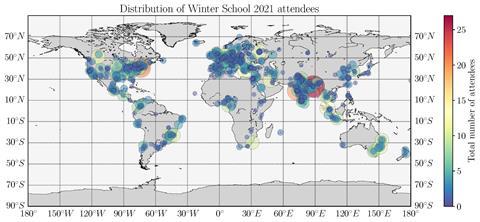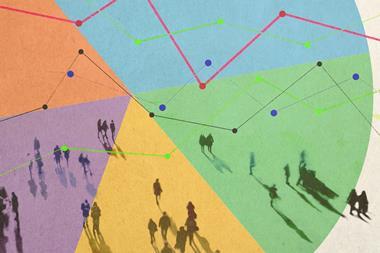How online conferences add together accessibility and inclusivity
In a world where opportunities, privilege and experience can vary drastically based on where you are born, online conferences and meetings are a great leveller. We have witnessed this for ourselves through the Virtual Winter School in Computational Chemistry (VWSCC). This online school, effectively a conference, has been running annually since 2015, motivated by the goals of accessibility, community building and supporting young scientists. Over the years, we have seen a growing number of attendees from a diverse range of career levels and geographic locations. Our 2021 edition, magnified by the effect of the pandemic, when conferences became inaccessible to the wider community, welcomed 2139 participants from 100 countries, over half of them students.

These findings convinced us that virtual meetings can indeed significantly broaden a community, and that accessibility is one of the greatest strengths of online mechanisms.
We have continued to explore accessibility and inclusivity as part of The Future of Meetings (TFOM) community. Our definition for accessibility is that everyone should be able to participate from wherever they are with as few restrictions as possible. Inclusivity means everyone feels welcome and wants to participate. In our experience, with accessibility and inclusivity in place, diversity will follow naturally.
For VWSCC, we initially thought of accessibility in terms of addressing financial disadvantage. One of our main principles is that VWSCC is free and we have been able to keep costs down through volunteers taking on organisational roles and using our own conference platform. Without pressure to recoup costs we also have flexibility with choice of speakers and have invited voices that do not often get heard.
We have since observed how online conferences can enable accessibility to a wider range of people. Technological advances and associated adaptive strategies such as captioning, screen readers, braille keyboards, audio description and mechanical aids make it possible for people with visual, hearing and physical impairments to join in conferences.
Accessibility costs should be budgeted from the beginning of the conference planning process, along with the coffee and cakes
But it isn’t enough to simply allow access. Organisers must design conferences with these needs at the forefront. We recommend asking participants about their accessibility requirements early in the organisational process, usually at registration but ideally earlier, so support can be provided where possible. We already see accessibility grants for childcare and travel to in-person conferences. For online conferences we have extended this list to assist with technological costs, for example to provide webcams, headsets or internet access. Accessibility costs should be budgeted from the beginning of the conference planning process, along with the coffee and cakes. An accessibility statement should also be provided to let participants know what tools are available, because online platforms are not all the same.
Accessibility should also inform how online meetings are structured. Ideally, meetings should be kept short with lots of breaks. Materials, such as slides and handouts, can be provided beforehand to mitigate the effects of screen fatigue, which can be especially tiring for neurodivergent and visually and hearing impaired people. The balance between synchronous (live) and asynchronous (in one’s own time) content should be considered, especially when multiple time zones are involved. Many aspects of effective collaborations, such as viewing recordings, can be handled asynchronously, reserving the live time to specifically focus on discussion and interaction.
The other part of the diversity equation, inclusivity, is all about conference etiquette, hence the importance of a clear and enforceable code of conduct. This should be designed to foster integrity and respect among the community, particularly taking into account the marginalised. Some of the increases in diversity in online conferences may not be reflecting inclusivity so much as technology’s ability to anonymise – the ability to instantly disappear when pushed past your comfort level. With true inclusivity no-one should feel the need to hide.
Additionally, online conferences have technical considerations to take into account to maintain an inclusive environment. Speakers should turn their cameras on to provide visual cues and allow attendees to lipread. When not speaking participants should remain muted to avoid confusing extraneous sound, which can distract everyone, but especially the visually impaired and neurodivergent.
Going online empowers more voices to take part in our scientific communities
As more people experience the benefits of online conferences, the benefits to the scientific community increase even further. The most recent VWSCC uncovered an unexpected side-effect of Covid conferencing: the quality of the student poster presentations was outstanding. There were fewer technical failures, showing how infrastructure has improved in developing nations, but the standout difference was the quality of the three minute poster pitches. The normalisation of online meetings has enabled people from all over the world to attend more conferences and they are learning from their peers and using each other as role models to polish their presentations. So online conferences aren’t just bringing more people to the chemistry world – they are bringing the wider world to the people too.
Our work in both VWSCC and TFOM has shown us how going online empowers more voices to take part in our scientific communities. By embracing the potential of online interaction and weaving it into the fabric of scientific collaboration, we can make sure to promote the diversity equation in favour of truly global and inclusive science.
Tips for accessible and inclusive online conferences
Before the conference
• Ask about accessibility requirements
• Offer accessibility support – financially and through assistive tools
• Provide an accessibility statement
• Provide a Code of Conduct and require acceptance as part of registration
• Structure meetings accordingly – short timezone friendly sessions with sufficient breaks
• Provide materials in advance
• Incorporate asynchronous elements to minimise impact of time zones
During the conference
• Give clear guidelines on expected behaviour
• Foster a respectful environment - role modelling, firm moderation
• Monitor the diversity of contributions and encourage participation
• Have video on when speaking
• Stay on mute when not
• Ensure there are many breaks throughout sessions
• Record live content to make it available for post-session viewing
After the conference
• Work with the global community to continue to raise and maintain awareness
• Factor accessibility costs into future budgets
• Develop adaptive strategies and assistive technologies












No comments yet